Navratri is here, and with it comes nine days of fasting and mindful eating. Many people avoid grains, packaged food, and certain spices. While fasting can be good for the body and mind, it can also upset digestion and energy if your meals aren’t balanced. One thing that often gets missed during Navratri is dietary fibre. Fibre helps you feel light, energetic, and comfortable, especially when your normal eating routine is disrupted. Adding fibre-rich foods to your Navratri meals can help you stay refreshed and active throughout the day.
Financial Express.com spoke to Dietitian Amreen Sheikh, Chief Dietician, KIMS Hospitals Thane, to find out which fibre-packed foods are best to include during the festival.
1. Keeps digestion in check
“Constipation and bloating are common during fasting because daily staples like rice and wheat aren’t eaten,” says Sheikh. She further added that many fasting foods, like sabudana (tapioca pearls), are filling but low in fibre. Adding high-fibre foods such as sweet potatoes, pumpkin, or raw bananas helps keep your bowel movements regular and prevents discomfort.
2. Helps you stay full for long
Fasting isn’t the same as starving, but mid-day hunger can hit hard if you don’t eat the right foods. “Low-fibre foods digest quickly, which makes you crave more snacks,” explains Sheikh. “Fibre-rich ingredients like buckwheat (kuttu) or water chestnut (singhara) flour can be used to make rotis, cheelas, or pancakes that are filling, healthy, and better than fried options.”
3. Maintains blood sugar levels
Light fasting meals often cause sudden energy drops. “Fibre slows the absorption of glucose, helping maintain stable blood sugar levels,” says Sheikh. She further added that a bowl of fresh fruits like apples, pears, or guavas provides both fibre and natural sugars, along with hydration. This won’t let you feel exhausted and you will be able to offer prayers, play garba without feeling exhausted.
4. Supports healthy weight control
Navratri fasting can act as a light detox, but overeating during the festival can make all your efforts go in vain. “High-fibre foods are low in calories but very satisfying,” shares Sheikh. “Take amaranth (rajgira) for example, whether you make porridge or laddoos, it provides fibre and protein that keep hunger at bay and prevent unnecessary snacking,” she further said.
5. Boosts your gut health
A healthy gut means better digestion, immunity, and even mood. “Fibre feeds the good bacteria in your stomach,” explains Sheikh. “Including simple vegetables like cucumber, bottle gourd, or carrot can give your gut the fibre it needs to stay healthy and function at its best.”
6. How to include fibre to your Navratri diet
Sheikh shares that it’s very simple to add fibre in your Navratri diet. She suggests starting your day with a colourful fruit bowl instead of plain milk-based foods, choose steamed or baked sweet potatoes instead of fried snacks, and use buckwheat or amaranth flour to make rotis or dosas. Adding nuts and seeds like almonds, walnuts, or chia to smoothies and desserts is another easy way to boost fibre in your diet. Keep yourself hydrated along with a fibre-rich diet to prevent bloating.
